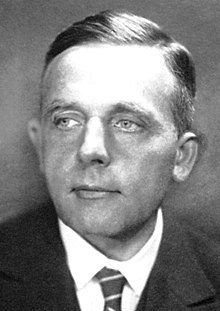Warburg hypothesis

The Warburg hypothesis (
Hypothesis
The
In the somatic mutation theory of cancer, malignant proliferation is caused by
Warburg articulated his hypothesis in a paper entitled The Prime Cause and Prevention of Cancer which he presented in lecture at the meeting of the Nobel-Laureates on June 30, 1966 at
The body often kills damaged cells by apoptosis, a mechanism of self-destruction that involves mitochondria, but this mechanism fails in cancer cells where the mitochondria are shut down. The reactivation of mitochondria in cancer cells restarts their apoptosis program.[11]
Continuing research and interest
A large number of researchers have dedicated and are dedicating their efforts to the study of the Warburg effect that is intimately associated with the Warburg hypothesis. In oncology, the Warburg effect is the observation that most
In particular, almost 18,000 publications have been published on the matter of ATP and the Warburg effect in the period 2000 to 2015. Most of the functions of the Warburg Effect have been the object of study.[18] Thousands of publications claim to have determined its functions or causes. Thomas N. Seyfried and Peter L. Pedersen are leading supporters of the Warburg hypothesis of the cause of cancer and consider experimental and other evidence to overwhelming favor it over the widely accepted somatic mutation theory.[19]
See also
- Carcinogen
- Carcinogenesis
- 2-Deoxy-D-glucose
- Pyruvic acid
- Cellular respiration
- Inverse Warburg effect
References
- PMID 13298683.
- PMID 25621294.
- S2CID 231437641.
- PMID 25621294.
- PMID 20459610.
- ^ O. Warburg, K. Posener, E. Negelein: Ueber den Stoffwechsel der Tumoren; Biochemische Zeitschrift, Vol. 152, pp. 319-344, 1924. (in German). Reprinted in English in the book On metabolism of tumors by O. Warburg, Publisher: Constable, London, 1930.
- S2CID 24155688.
- S2CID 12467031.
- S2CID 17778749.
- PMID 20737302.
- S2CID 477272.
- PMID 25621294.
- PMID 26864256.
- PMID 24310355.
- S2CID 10866959.
- PMID 16982728.
- S2CID 76665891.
- ^ The Warburg Effect: How Does it Benefit Cancer Cells? Trends in Biochemical Sciences- M.V. Liberti, J.W. Locasale. January 2016
- ISBN 9780470584927.
Further reading
- Warburg O (24 February 1956). "On the Origin of Cancer Cells". PMID 13298683.
